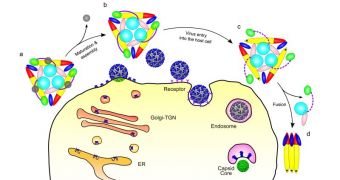Researchers from Purdue University and Pasteur Institute, discovered the atomic-scale arrangement of proteins in a structure, which allows a virus to invade and fuse with host cells, and they showed the way that the structure morphs with changing acidity and starts infection.
The Purdue team showed the structure of the protein in an acid environment, while the Pasteur team showed it in a neutral environment.
Once the two researches combined, it is easy to see what happens to the structure when a virus enters and then prepares to fuse with a host cell – critical steps leading to infection.
The researchers focused on a family of viruses including eastern equine encephalitis and chikungunya viruses (also called alphaviruses), that are transmitted by mosquito or tick bite.
They studied two "envelope proteins" making up 80 spike-like structures standing out of the outer shell of the viruses.
"The spikes have all the machinery for infecting a cell," said Michael Rossmann, Purdue's Hanley Distinguished Professor of Biological Sciences, who is working with Long Li, a postdoctoral researcher in his lab, and Joyce Jose, a postdoctoral researcher in the laboratory of Richard Kuhn, a professor and head of Purdue's Department of Biological Sciences, and added that “these findings represent a milestone.”
The scientists already knew the structure of envelop protein 1, or E1, and now, the Purdue researchers have found the structure of envelope protein 2 and the exact atomic-scale architecture of the combined E1-E2 complex.
Previous research found E2's location in the protein complex, but this is the first time that scientists find out its structure.
E2 is very important as it is a receptor-binding protein, which attaches the virus to the host cells, and once the virus has found an acidic environment that changes the structure of the protein complex, it enters the cells.
These changes expose a part of E1, necessary for fusing the virus with the cell membrane; this leads to a "fusion pore" forming, through which the genetic material of the virus is transferred into the host cell.
Once the host cells is infected, it produces new virus particles.
The goal of this research was to find out the way that viruses infect humans and other hosts, so the scientists used advanced imaging technologies (including cryoelectron microscopy and X-ray crystallography) to uncover critical structural details about the viruses.
This could lead to better vaccines and antiviral drugs, according to Rossmann, who, along Kuhn, has been leading the Purdue team on the study of alphaviruses for the past 15 years, at Purdue's Markey Center for Structural Biology.
Purdue is also working on a research financed by a federal fund, trying to develop better vaccines and antiviral drugs against alphaviruses and flaviviruses, West Nile and dengue included.
There are two papers appearing in the journal Nature today, presenting the findings from the Purdue and Pasteur Institute studies, research funded by the National Institutes of Health.

 14 DAY TRIAL //
14 DAY TRIAL //